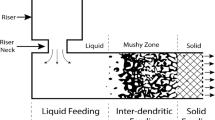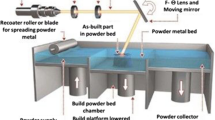Abstract
In this study, a methodology has been presented for radial positioning of the die holes in multi-hole extrusion of non-symmetric sections. The objective of radial positioning is to minimize exit profile curvature. For this purpose, a two-hole die with non-symmetric T-shaped holes has been investigated. A kinematically admissible velocity field at deformation zone has been developed. The deformation region includes the dead metal zone (DMZ) which is assumed to be linear. The DMZ length was obtained by energy minimization through the upper bound method. To predict the exit profile curvature a deviation function has been suggested. Using the proposed function, the velocity field has been used for prediction of the exit profile curvature and thereby positioning of the die holes. The predictions of the proposed methodology were validated with physical modeling. With little development, this methodology could be applied to dies, which have more holes and/or generate profiles that are more complex. This will help die designers enhance the quality of extrusion process.












Similar content being viewed by others
Abbreviations
- e1, e2:
-
Off-centricity values of exit section in X and Y directions, respectively
- \( (e3,e4),(e5,e6) \) :
-
Co-ordinates of center points at exit and at entry
- \( f,g,h \) :
-
Position vector components of any particle inside the deformation zone in X, Y and Z directions, respectively
- u, q, t :
-
Parameters changing between 0 and 1
- \( F_{1} ,F_{2} \) :
-
Conformal functions
- \( R \) :
-
Initial billet radius
- L :
-
DMZ length
- L c :
-
Billet length outside the assumed deformation zone
- V 0 :
-
Entry velocity
- A 0 :
-
Billet cross sectional area
- RA :
-
Reduction in area
- y c :
-
Centroid of semi-circle
- \( \dot{W}_{tot} \) :
-
Upper bound on extrusion power
- \( \dot{W}_{d} \) :
-
Power of deformation in the assumed converging deformation region
- \( \dot{W}_{i} ,\dot{W}_{e} /\dot{W}_{f} ,\dot{W}_{s} ,\dot{W}_{fc} \) :
-
Power consumptions due to plastic deformation, shear (entry/exit), friction at the surface of DMZ and friction at the billet–container interface, respectively
- m c :
-
Constant of friction factor at the billet–container interface
- Y :
-
Yield stress of billet
- V x , V y , V z :
-
Velocity components in X, Y and Z directions, respectively
- G(u, q, t):
-
Improved velocity function
- M 3 :
-
Friction function
- b 1, b 2, b 3 :
-
Constants of friction function
- J :
-
Jacobian
- \( \det J \) :
-
Determinant of Jacobian
- \( P_{nor} \) :
-
Normalized extrusion pressure
- \( \Delta V_{e} ,S_{e} \) :
-
Velocity discontinuity and surface of velocity discontinuity at entry
- \( \Delta V_{f} ,S_{f} \) :
-
Velocity discontinuity and surface of velocity discontinuity at exit
- \( K_{xz} ,K_{yz} \) :
-
Exit profile curvature in XZ and YZ planes, respectively
- \( \phi ,\theta \) :
-
Angle of the deforming region at the entry and at the exit of the assumed converging deformation zone
- \( \rho_{0} \) :
-
Sweep radius at the entry of deformation zone
- \( \rho_{1} ,\rho_{2} \) :
-
Radius of the deforming region at the entry and at the exit, respectively
- \( \gamma_{r} ,\gamma_{d} \) :
-
Angle of inclination of a surface element within the deformation zone in radians and degree respectively
- \( \kappa_{xz} ,\kappa_{yz} \) :
-
Curvature of the extruded profile from triangular elements in XZ and YZ planes
References
Chen FK, Chuang WC, Torng S (2008) Finite element analysis of multi-hole extrusion of aluminum-alloy tubes. J Mater Process Technol 201:150–155
Johnson W, Mellor P, Woo D (1958) Extrusion through single hole staggered and unequal multi-hole dies. J Mech Phys Solids 6:203–222
Nagpal V, Altan T (1975) Analysis of three dimensional metal flow in extrusion of shapes with the use of dual stream function. In: Proceedings of the 3rd NAMRC, Carnegie-Mellor University, Pittsburgh
Webster W (1978) A three dimensional analysis of extrusion and metal forming by the finite element method. PhD. Dissertation, University of Missouri-Rolla
Keife H (1993) Extrusion through two dies openings: a 2D upper-bound analysis checked by plasticine experiments. J Mater Process Technol 37:189–202
Ulysse P, Johnson RE (1998) A study of the effect of the process variables in unsymmetrical single-hole and multi-hole extrusion processes. J Mater Process Technol 73:213–225
Kar PK, Sahoo SK, Das NS (2000) Upper bound analysis for extrusion of T-section bar from square billet through square dies. Meccanica 35:399–410
Chitkara NR, Celik KF (2000) A generalized CAD/CAM solution to the three dimensional off-centric extrusion of shaped section: analysis. Int J Mech Sci 42:273–294
Chitkara NR, Celik KF (2001) Extrusion of non-symmetric T-shaped sections, an analysis and some experiments. Int J Mech Sci 43:2961–2987
Lee GA, Im YT (2002) Analysis and die design of flat-die hot extrusion process 2. Numerical design of bearing lengths. Int J Mech Sci 44:935–946
Peng Z, Sheppard T (2004) Simulation of multi-hole die extrusion. Mater Sci Eng, A 367:329–342
Fang G, Zhou J, Duszczyk J (2009) FEM simulation of aluminium extrusion through two-hole multi-step pocket dies. J Mater Process Technol 209:1891–1900
Sinha MK, Deb S, Dixit US (2009) Design of a multi-hole extrusion process. Mater Des 30:330–334
Sinha MK, Deb S, Das R, Dixit US (2009) Theoretical and experimental investigations on multi-hole extrusion process. Mater Des 30:2386–2392
Assempour A, Hasannejadasl A (2009) Minimization of the exit profile curvature in non-symmetric T-shaped sections in the extrusion process. Mater Des 30:1350–1355
Meybodi AK, Assempour A, Farahani S (2012) A general methodology for bearing design in non-symmetric T-shaped sections in extrusion process. J Mater Process Technol 212:249–261
Chen WJ, Chen DC, Su WC, Nian FL (2012) Optimization design of parameters with hybrid particle swarm optimization algorithm in multi-hole extrusion process. In: Advances in electronic engineering, communication and management vol 2. Lecture notes in electrical engineering, vol 140. Springer, Berlin, pp 279–284
Haghighat H, Moradmand M (2013) Upper bound analysis of thick wall tubes extrusion process through rotating curved dies. Meccanica. doi:10.1007/s11012-013-9714-y
Karami P, Abrinia K, Saghafi B (2014) A new analytical definition of the dead material zone for forward extrusion of shaped sections. Meccanica. doi:10.1007/s11012-013-9794-8
Bingol S, Keskin MS, Ayer O, Sarikaya K, Burucu O, Alipur P (2014) FE analyzing of layout types for multi-hole extrusion dies. Modern methods of construction design, Lecture notes in mechanical engineering, doi: 10.1007/978-3-319-05203-8_1
Acknowledgments
The authors would like to thank Mr. Vahid Aligholizadeh for his helps and comments.
Author information
Authors and Affiliations
Corresponding author
Rights and permissions
About this article
Cite this article
Nazari Onlaghi, S., Assempour, A. On the minimization of the exit profile curvature in extrusion through multi-hole dies: a methodology and some verifications. Meccanica 50, 1249–1261 (2015). https://doi.org/10.1007/s11012-014-0080-1
Received:
Accepted:
Published:
Issue Date:
DOI: https://doi.org/10.1007/s11012-014-0080-1




